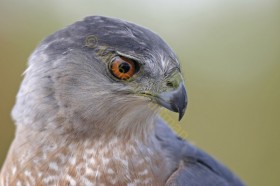Cooper’s Hawk (Accipiter cooperii)

Peak Migration: mid Sept – early Oct
Record Daily High: 43 on 15 Sep 1999
Record Seasonal High: 319 in 1993
Peak Migration: early Apr – early May, and mid Sept – early Oct
Named for William Cooper, who shot the type specimen in 1828.
Other names: Big blue darter, chicken hawk, hen hawk, quail hawk, striker, swift hawk. Sometimes “coop” for short.
Hunting habits: Catches small to medium-sized birds and mammals on the wing, from warblers to flickers and doves to chipmunks, squirrels, and even fish. One study in New York showed that European Starlings were the most common bird eaten.
Nesting habits: Highly variable nesting but generally in large coniferous or deciduous tree; often on top of a pre-existing base of a squirrel or raptor nest. The species nests locally in the Duluth region in extensive forests, woodlots, and commonly in pine plantations or suburban areas. Like many raptors, the species will vigorously defend their nests. Nests are typically 8- 15 meters (25-50 feet) high with clutch sizes ranging from 3-5 eggs. Incubation lasts from 30 to 36 days and young leave the nest after 30-34 days.
Migratory habits: At Hawk Ridge most individuals migrate from mid-September to early October; though migration can begin in early August and individuals have been counted as late as early December.
Measurements:
Length: Males about 39 cm (15 inches); females about 45 cm (17 inches)
Wingspan: 74-94 cm (29-37 inches)
Weight: Males about 350 grams (12 ounces); females about 530 grams (1 lb 3 oz)
Life expectancy: Maximum reported age was 12 years.
Suggested reading: Rosenfield, R.N. and J. Bielefeldt. 1993. Cooper’s Hawk in Birds of North America, No. 75.
Image Credits: Michael Furtman

